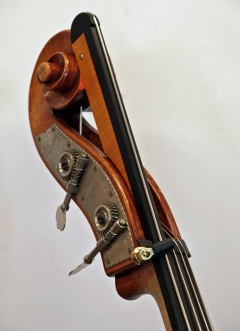
Pianzola Instrumentenbau
Georg Pianzola
Friedbühlstrasse 36b
3008 Bern
Telefon: +41 31 398 23 80
Fax: +41 31 398 23 81
pianzola@kontrabass.ch
Öffnungszeiten:
Dienstag bis Freitag
14:00 - 18:00 Uhr
Samstag 11:00 bis 16:00 Uhr
Montag ganzer Tag geschlossen.
Besuche bitte telefonisch anmelden!
My magic Number
After over 30 years of working on doublebasses, I found out a magic number to calculate the exact lenght of the C - Extension. An easy way to make the calculation by any stringlenght.
A magic number for simple calculation of the subcontra C extension for the double bass, written by Giorgio Pianzola, Doublebassbuilder in Bern
In and of itself, the C extension on the double bass is nothing new. Musical scores often call for extending the E string downward by a third, a move that makes sense in a variety of musical styles. As an alternative to a bulky 5-stringed doublebass, this design offers multiple advantages at the same time. The extreme length of the string makes the deep tones sound much clearer. The neck remains slender, making music much easier to play. The string can be stopped with a simple clasp on the E, and the bass can again be played as a normal 4-stringed instrument.
Still, not all violin makers are willing to attempt this conversion. To some, it is not quite clear how the extension is to be fastened in place, while others cannot determine the length by which to extend the string. That is why, after countless conversions on the double bass, I sat down and calculated a number to which any violin maker can refer to quickly and easily compute the precise length of the C Extension. This coefficient can be applied to a vibrating string of any length whatsoever, as these lengths are practically unique to each individual double bass.
As we know from guitars, fret positioning can be mathematically computed. The magic number here is 17.817. In other words, dividing the length of the vibrating string by 17.817 yields the precise distance from the first semitone to the oversaddel. After subtracting this length from the total length of the string, the remainder is again divided by 17.817, and so on and so forth, until one arrives, at the 12th fret, at one-half of thelength of the string: the octave. Here it is easy to see whether the calculation is correct, as the number must result in precisely half the length of the open string. That is the nature of the octave!
So much for calculations in which the aim is to shorten the string. But what we want to do is lengthen a string !
For this calculation, all you need is a good calculator, one that goes beyond four places after the decimal, a pencil or pen and a piece of paper. Take the vibrating length of the string on the double bass you wish to convert – for instance 104 cm – and multiply this by my magic number, 1.05946313 ! The result is 110,184166 cm, or the position of an E- flat. The calculation can now be repeated, with this result again multiplied by 1.05946313 . The result is 116.736062, a D. Continuing, you arrive at 123,677554 for a D flat and 131.031809 cm for subcontra C. Subtracting the 104cm from this total yields the exact length by which the E string must be extended to have it play a perfect C, or 27,031809 cm!
As none of us works with a precision down to the nearest thousandth of a millimetre, 27.03 cm will certainly suffice. But the precise calculation has been performed and can be presented to the customer by way of proof. I recommend continuing the computation out to the octave, to prove to yourself and the customer how precise this number is. In this case, the octave would be located at 208,000092 cm!
With this in mind, I wish all my colleagues and all bassbülayers great success and lots of fun
Yours truly, Giorgio Pianzola, Double Bass Builder, Bern, Switzerland 25 September 2013
© copyright Text, Fotos and the Calculation Giorgio Pianzola Bern 25. September 2013
